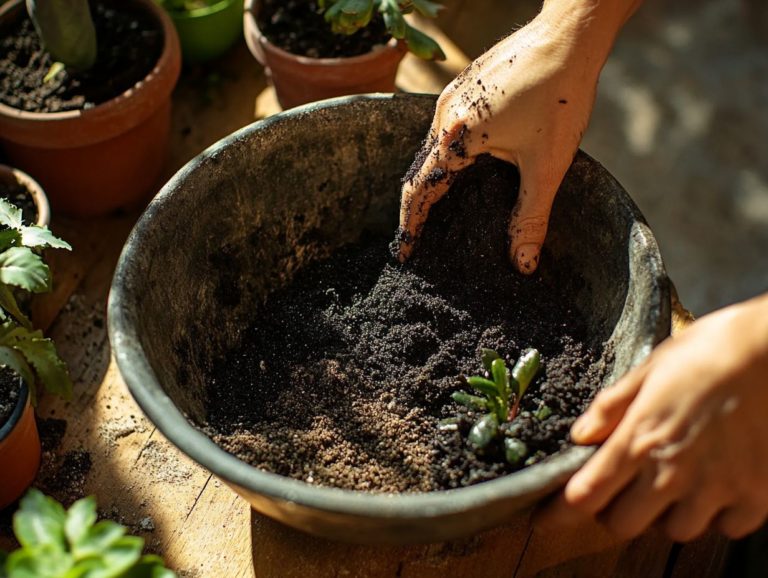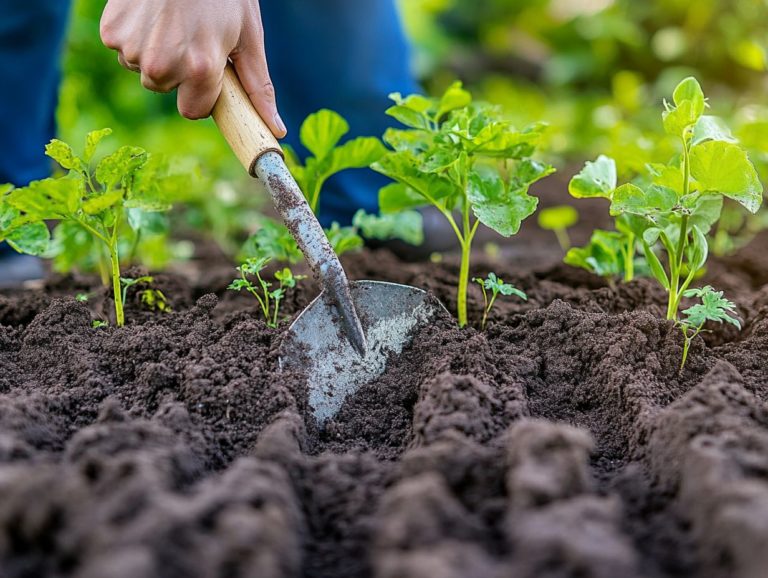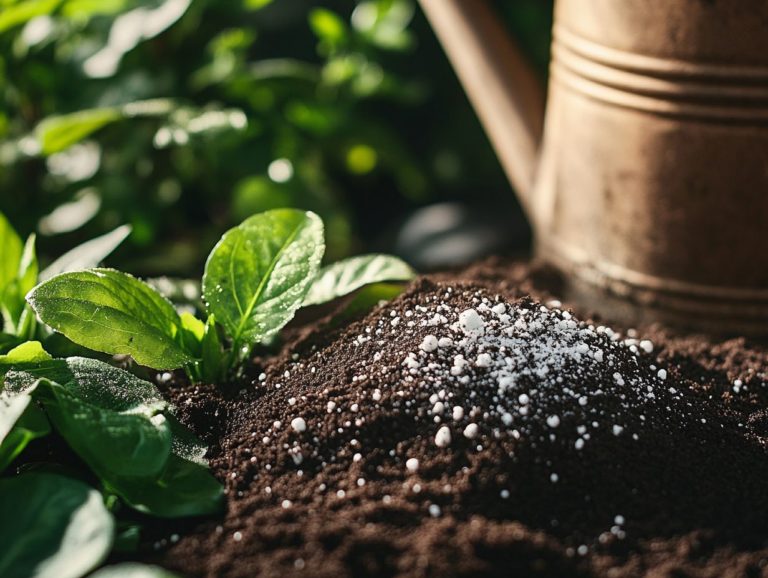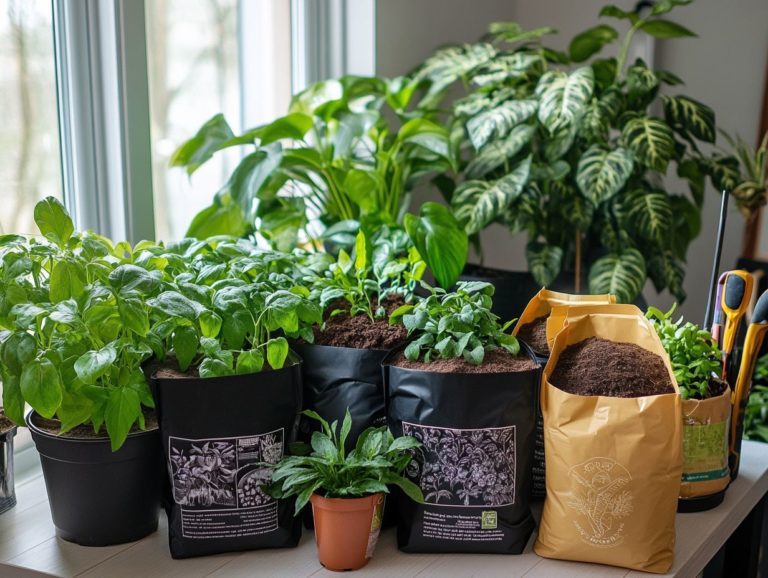Understanding Soil Structure for Plant Growth
Soil structure is crucial to the vitality of your plants, affecting everything from water retention to root development.
This article delves into the importance of soil structure, examining various types such as granular, blocky, and plate-like formations. You ll discover how different environmental and human factors can impact soil structure, along with effective methods to enhance it.
Get ready to explore exciting tools and techniques for assessing soil quality, ensuring your plants not only survive but truly thrive. Explore with us the essential connection between soil structure and plant growth!
Contents
- Key Takeaways:
- The Importance of Soil Structure for Plant Growth
- Types of Soil Structures
- Factors Affecting Soil Structure
- Improving Soil Structure
- Assessing Soil Structure for Plant Growth
- Frequently Asked Questions
- What is soil structure and why is it important for plant growth?
- What are the main types of soil structures?
- How does soil structure affect water retention and drainage?
- What are some signs of poor soil structure?
- How can I improve soil structure for better plant growth?
- Can soil structure vary in different parts of my garden?
Key Takeaways:

- Soil structure is crucial for plant growth because it affects water and nutrient availability, root growth, and soil aeration.
- There are three main types of soil structures: granular, blocky, and plate-like, each with different characteristics that affect plant growth.
- Environmental factors such as climate and land management practices, as well as human activities like compaction and erosion, can significantly impact soil structure and plant growth.
The Importance of Soil Structure for Plant Growth
Soil structure is fundamental to plant growth, acting as the bedrock for agricultural productivity and the overall vitality of ecosystems. When soil is well-structured, it facilitates efficient water infiltration, enhances nutrient cycling, and nurtures a diverse array of soil organisms elements that collectively drive increased crop yields.
Understanding soil structure is crucial in the context of climate change, as it aids in mitigating environmental impacts and supports initiatives aimed at clean water. By prioritizing soil health, you can ensure sustainable agriculture and foster biodiversity both of which are crucial for resilient ecosystems.
Why Soil Structure Matters
Soil structure is vital for maintaining agricultural productivity, as it has a direct impact on soil health and nutrient cycling.
When you have well-structured soil, it forms a network of pores and aggregates that create ideal conditions for the soil microbiome, the community of tiny organisms in the soil that help break down matter and release nutrients. This interconnected environment not only enhances the movement of air and water but also encourages the growth of beneficial microorganisms that support crop development.
A healthy soil structure allows roots to penetrate more easily and access vital resources, making it crucial for sustainable farming practices. By understanding and managing soil structure effectively, you can achieve improved yields and greater resilience in your agricultural systems.
Types of Soil Structures
Understanding the various types of soil structures like granular, blocky, and plate-like formations is key to mastering effective soil management and boosting agricultural productivity.
Each soil structure significantly influences how well the soil retains water, supports root growth, and facilitates nutrient cycling. For instance, granular structures excel in promoting water infiltration and aeration, while blocky structures enhance soil retention and create a thriving habitat for a diverse range of soil organisms.
By recognizing these nuances, you can refine your soil management practices, ultimately optimizing soil health and maximizing agricultural yields.
Start improving your soil structure today for healthier plants!
Granular, Blocky, and Plate-like Structures
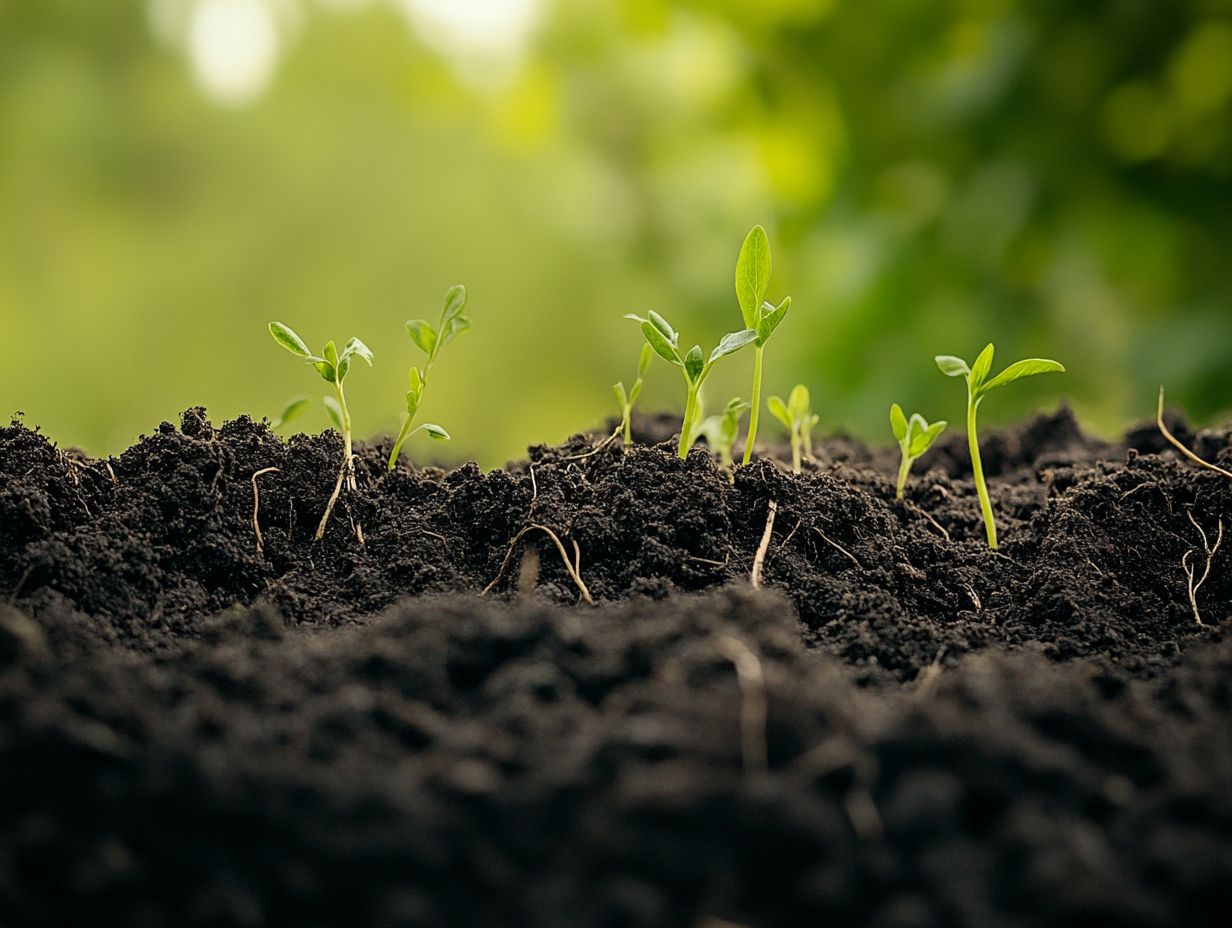
Granular, blocky, and plate-like soil structures each have unique characteristics that influence soil health and crop growth.
Granular structures look like tiny crumbs. They improve aeration and water flow, which are vital for root growth and beneficial microbes.
Blocky structures, often found in clay-rich soils, provide stability and help with nutrient retention, crucial for healthy plants.
Plate-like structures have a flat shape. They block water movement and root growth, which can cause poor drainage and compacted soil.
The diversity of these soil aggregates fosters biodiversity by creating varied habitats for organisms, contributing to a resilient soil ecosystem that supports agricultural productivity.
Factors Affecting Soil Structure
Many factors affect soil structure and health. Environmental conditions and human actions, like farming, play a key role.
Soil compaction, often caused by heavy machinery and intensive farming, can harm soil structure, reducing water infiltration and nutrient cycling.
Adding organic matter helps preserve healthy soil aggregates and enriches the soil microbiome.
Understanding these factors is essential for implementing effective soil management practices that support sustainable agriculture and mitigate climate change impacts.
Environmental Factors and Human Activities
Environmental factors such as rainfall, temperature, and vegetation cover, along with human activities like agriculture and urbanization, are crucial in shaping soil structure.
These elements interact in ways that affect soil compaction and moisture retention. For example, heavy rainfall can create waterlogged conditions, leading to soil compression. Excessive heat can dry the soil, causing cracks and degradation. Disruptive practices like intensive farming and frequent construction can upset the natural balance of soil.
To maintain soil structure, it’s vital to add organic matter, such as compost or plant residues. This not only improves moisture retention but also promotes a thriving ecosystem of beneficial microorganisms, leading to healthier crops and sustainable agricultural productivity.
Improving Soil Structure
Improving soil structure is essential for enhancing soil quality and boosting agricultural productivity. You have several effective methods to achieve this.
Increasing organic matter content through cover cropping and compost application significantly improves soil aggregates, enhancing water infiltration and nutrient cycling.
Using no-till farming practices prevents soil compaction, which is vital for maintaining healthy soil structure. These management techniques support sustainable agriculture while fostering biodiversity.
Methods for Enhancing Soil Quality
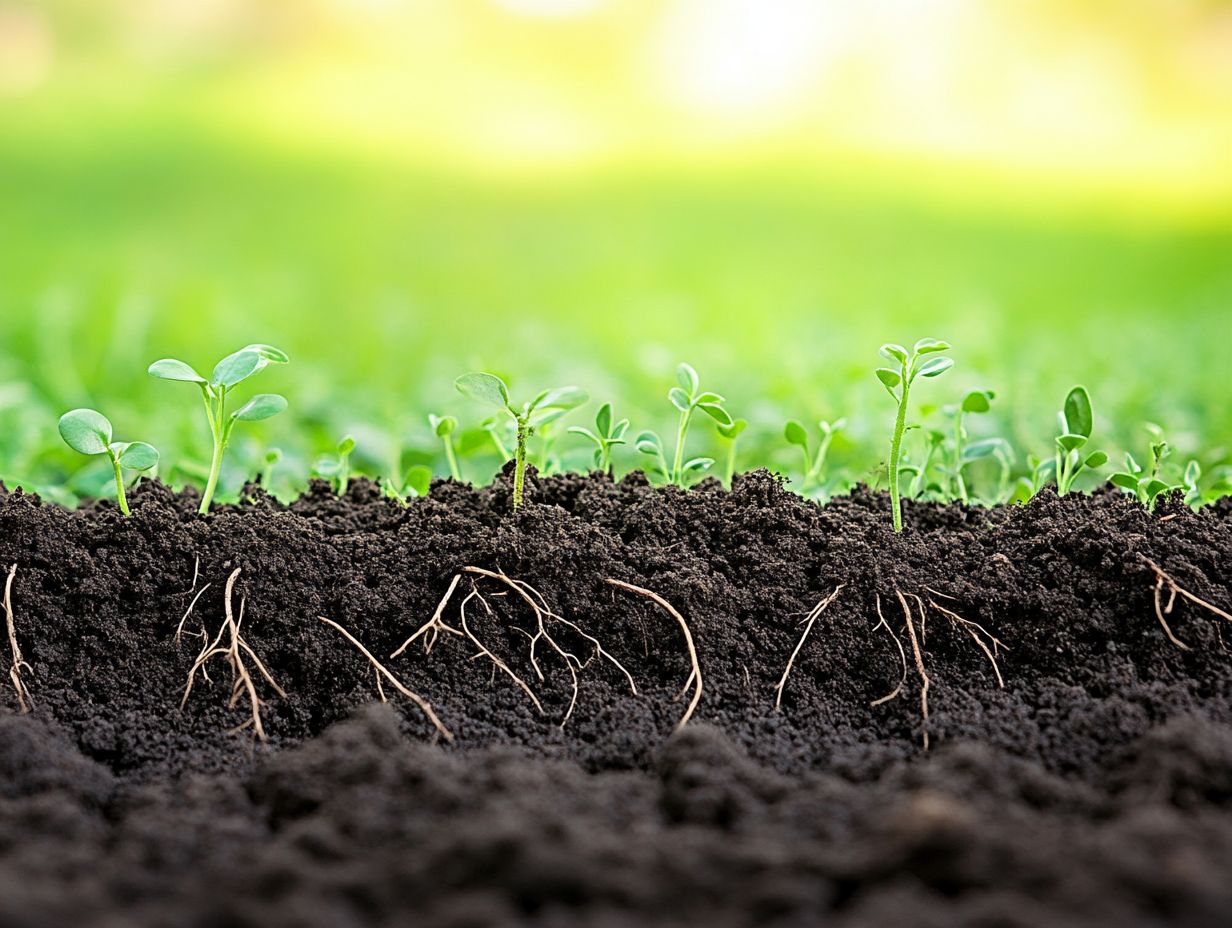
Effective methods for enhancing soil quality focus on increasing organic matter and improving water infiltration to support crop growth.
Incorporating organic amendments like compost and manure elevates nutrient levels and nurtures beneficial microorganisms that enhance soil health.
Implementing crop rotation techniques diversifies plant species and disrupts pest cycles, improving both soil structure and nutrient cycling.
Using reduced tillage practices minimizes soil disturbance, helping preserve integrity and moisture levels. Together, these strategies create a holistic approach to soil management that revitalizes the earth and boosts agricultural productivity, paving the way for a sustainable future in farming.
Take Action: Start applying these methods to enhance your soil structure today. Your crops and the environment will thank you!
Assessing Soil Structure for Plant Growth
Assessing soil structure is crucial for understanding its influence on plant growth. You have various tools and techniques for effective soil measurements. By analyzing clumps of soil that help retain moisture and nutrients and the ability of soil to allow water to pass through, you can gain insights into your soil’s health. This knowledge enables you to make informed decisions about management practices.
Techniques like soil core sampling and aggregate stability tests offer valuable data regarding soil structure. These assessments guide best practices and support sustainable agriculture and biodiversity conservation.
Tools and Techniques for Soil Analysis
Various tools and techniques for soil analysis are essential for achieving accurate measurements and gaining a deeper understanding of soil health.
By implementing soil probes, you can extract samples at different depths, revealing valuable insights into nutrient stratification. Moisture sensors play a pivotal role, continuously monitoring soil moisture levels. This is crucial for effective irrigation management and assessing drought conditions.
Laboratory testing methods reveal crucial insights into soil composition, helping your crops thrive by identifying elements and compounds that significantly affect fertility and plant productivity. Each of these instruments assists you in assessing soil structure and guides you in developing evidence-based strategies for sustainable soil management, ensuring your crops flourish while protecting the ecosystem.
Frequently Asked Questions
What is soil structure and why is it important for plant growth?

Soil structure is how soil particles are arranged. This arrangement affects how well water, air, and nutrients can reach your plants, which are essential for growth and development.
What are the main types of soil structures?
The main types of soil structures are granular, blocky, prismatic, columnar, platy, and single-grained. These structures are determined by the size, shape, and arrangement of soil particles, greatly impacting the ability of plants to grow and thrive.
How does soil structure affect water retention and drainage?
Soil structure plays a crucial role in water retention and drainage. A well-structured soil with plenty of pore spaces can hold onto water and nutrients, making them available to plants. Conversely, compacted or poorly structured soils can hinder the movement of water and nutrients, leading to poor drainage and potentially causing waterlogged conditions that can harm plant roots.
What are some signs of poor soil structure?
Poor soil structure can manifest in several ways, including compacted or hard soil, slow water infiltration, water pooling, poor drainage, and stunted plant growth. These signs may indicate that the soil lacks essential pore spaces necessary for air, water, and nutrient movement.
How can I improve soil structure for better plant growth?
There are several ways to improve soil structure for optimal plant growth. Incorporating organic matter, such as compost or aged manure, reducing tillage to avoid soil compaction, and avoiding heavy machinery on wet soil can help. Planting cover crops and rotating crops can also improve soil structure by adding diversity and promoting beneficial soil organisms.
Can soil structure vary in different parts of my garden?
Yes, soil structure can vary significantly in different parts of a garden or even within the same garden bed. Factors such as soil type, slope, drainage, and previous land use can all influence soil structure. Regularly assessing and monitoring soil structure in different areas is essential for ensuring optimal plant growth and making necessary adjustments.
Start assessing your soil today to give your plants the best chance to thrive!

